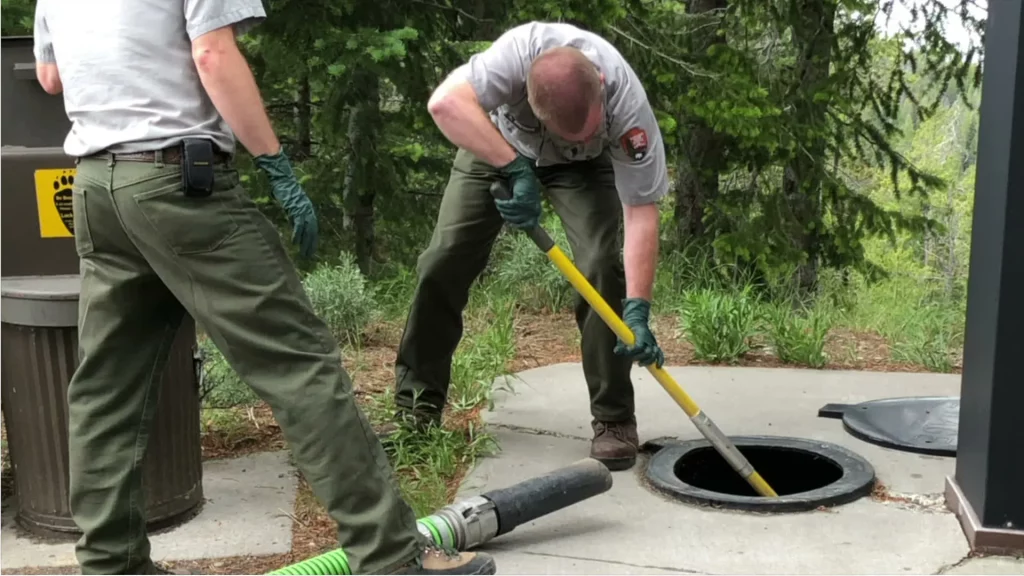All wastewater from toilets, showers and sinks flows into the septic tank. Heavy solids settle to the bottom where bacteria reduce them into sludge, and lighter materials float to the top as grease.
Have your septic tank pumped regularly. Pumping will prevent a variety of wastes from polluting the soil and groundwater around your home.
Pumping
Septic tanks are large, underground, watertight containers that hold all wastewater from toilets, bathtubs, showers, sinks, and kitchen drains. Solid waste flows into the tank, where bacteria break it down into sludge and gasses. The liquid waste, called effluent, flows out of the tank into a septic system drain field. If too much solid waste is in the septic tank, it can flow into the drainfield and clog it. When this happens, sewage can back up into the house and pollute nearby water supplies.
The amount of solid waste in a septic tank determines how often it needs to be pumped. Homeowners with multiple bathrooms and a lot of people using them are more likely to need frequent pumping. Likewise, homes with heavy use of garbage disposals generate more solids and may need pumping twice as often as those that rarely or never use their disposals.
A professional septic service can help homeowners establish an appropriate pumping schedule for their tank. They also inspect the tank and the drainfield to ensure they are functioning properly. They will note any necessary repairs and give homeowners recommendations for future maintenance and upgrades.
When you hire a septic tank pumping company, they will send out a truck with a giant tank and a big suction hose that basically sucks up your septic waste like a vacuum. The technician will first need to locate the septic tank, which may involve digging up some of your yard. Once they have found it, they will open the access lid and start pumping.
They will also use a muckrake to break up sludge and scum in the tank, which helps it be removed more easily. During this time, the technician will also be listening to your tank to hear if there are any leaks or other problems.
Once the tank is emptied, the service professionals will return to refill it with clean water. They will also do a final inspection of the drainfield and pipes. If you are selling your home, the professional will provide a certificate that indicates the septic tank was pumped and inspected recently. This will make the sale of your property go through more smoothly.
Inspecting
The first step in septic tank maintenance is a visual inspection. This is usually done by a home inspector before the house goes on the market and may include flushing toilets and running water to check that the system can handle the load. The inspector will look for signs of sewage leaks like thick lush grass around the drain field, spongy ground and foul odors.
The inspector should also look at the sludge and scum layers in the septic tank. The sludge layer should be at or near the bottom of the tank, and the effluent layer should be at or above the inlet baffle. The sludge should not be within 25 to 33 percent of the liquid capacity of the tank. If the sludge layer is too high, the tank needs to be pumped.
A septic system is designed with baffles at the inlet and outlet to regulate waste flow. The inlet baffle prevents too much solid waste from entering the tank at once, and the outlet baffle keeps solids from clogging the drain field lines. If these baffles are missing or broken, they need to be replaced. The inspector should also inspect the distribution box and ensure that each drain line is receiving an equal amount of wastewater.
Cracks in the septic tank can allow wastewater to seep into the ground, which is a major problem because of the contamination it causes. The inspector should not enter the septic tank, but should keep an eye out for any cracks that may indicate a serious failure of the septic system.
A septic tank and drain field can be protected by installing risers, which are extensions from the tank and distribution box to the ground surface. This makes it easier to access the tank for pumping and inspection. Also, the drainfield can be protected by directing surface runoff and roof drains away from it and keeping vegetation to a minimum. This will help the system work as well as possible, and will reduce the chance of a catastrophic failure. This type of failure can result in raw sewage back up into the house, causing permanent odors, stains and water damage.
Cleaning
Many homeowners choose not to use the public sewer system, opting instead for a septic tank and drain field. Also called on-site sewage systems, these treat septic waste at the point where it is generated rather than sending it to the landfill. Septic tanks are large containers that hold wastewater, separating the solids from the liquid waste. After the solids are broken down by microorganisms, the liquid moves into a drain or leach field, where it is absorbed into the surrounding soil.
The septic tank needs to be pumped and cleaned on a regular basis to keep it working properly. This is especially true when too much solid waste builds up inside the tank. The septic tank contains an ecosystem of bacteria that break down most of the organic waste, but it can only handle so much. Over time, the bacteria will need to rest, and a layer of sludge will form over the top of the liquid waste. This layer should be pumped out when it is 3 inches thick or more.
During the pumping process, technicians insert a long vacuum-like hose into the manhole and suction out the entire contents of the septic tank. This allows the septic tank to be emptied completely, removing the sludge layer and preventing it from building up again. The septic tank cleaning process is similar, but it involves more thorough work. Technicians will remove the scum layer from the surface of the septic tank and stir the contents to make sure that all the liquids are drained as well.
In addition to routine pumping and cleaning, there are other steps that homeowners can take to maintain their septic system. They should only use toilet paper that is designed to be safe for septic tanks and should avoid flushing down the drain any waste that doesn’t degrade quickly, such as coffee grounds, baby wipes, feminine products, medication, food scraps, eggshells, produce stickers, oil or grease. These items will clog the drain field or septic tank and can cause costly repairs.
It’s also important to ensure that the septic tank is easy to access for inspection and cleaning. This means keeping the area clear of trees, shrubs and cars. If the septic tank is buried, a riser should be installed so that the lid can be easily lifted up.
Repairing
Occasionally, your septic system may need some form of repair to keep it functioning correctly. This is particularly true of systems that are older or those that have been subjected to extensive storm damage. Whether you want to repair or replace your septic tank, the best option is to have it inspected and evaluated by a professional. They will be able to tell you whether the repair is in your best interest or if you should just get a replacement.
One of the first signs that your septic system isn’t working properly is when water drains slowly from the sinks and showers in your home. This can be a sign of an obstruction in a single pipe or it could mean that the septic tank needs to be pumped. Alternatively, it could indicate that the drain field has been overloaded with solids.
Another sign that you might need to have a septic tank repaired is the strong smell of sewage in your home. If you are noticing this smell, it’s a good idea to call a drainage company to have the system inspected. Moreover, you should also look at the outside of your septic tank for additional indications that something is wrong with it. This includes a leaking tank or a cesspool that is overflowing and causing untreated effluent to enter the soil surrounding it.
If you do suspect that your septic system needs to be repaired, the first thing that you should do is gain access to the tank by uncovering both the inlet and outlet access covers. Then, you should use a stick to measure the thickness of the layers of scum and sludge. You should have your septic tank pumped if the sludge layer is more than 12 inches thick or the scum layer is above the inlet baffle.
You should also check the condition of the septic tank lid and make sure that it is not cracked. If your septic tank lid cracks, you should have it repaired as soon as possible. Otherwise, it will start to leak and can cause a lot of problems with your wastewater disposal system.


